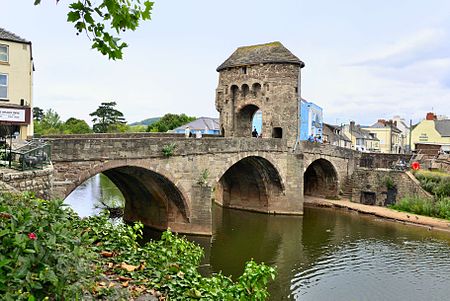Monmouth

Monmouth ( MON-məth, MUN-; Welsh: Trefynwy meaning "town on the Monnow") is a town and community in Wales. It is situated where the River Monnow joins the River Wye, two miles (three kilometres) from the Wales–England border. Monmouth is 30 miles (50 km) northeast of Cardiff, and 113 miles (182 km) west of London. It is within the Monmouthshire local authority, and the parliamentary constituency of Monmouth. The population in the 2011 census was 10,508, rising from 8,877 in 2001. Monmouth is the historic county town of Monmouthshire although Abergavenny is now the county town. The town was the site of a small Roman fort, Blestium, and became established after the Normans built Monmouth Castle c. 1067. The medieval stone gated bridge is the only one of its type remaining in Britain. The castle later came into the possession of the House of Lancaster, and was the birthplace of King Henry V in 1386. In 1536, it became the county town of Monmouthshire. A market town and a focus of educational and cultural activities for the surrounding rural area, Monmouth has become a tourism centre at the heart of the Wye Valley.
Excerpt from the Wikipedia article Monmouth (License: CC BY-SA 3.0, Authors, Images).Monmouth
Monnow Keep,
Geographical coordinates (GPS) Address Nearby Places Show on map
Geographical coordinates (GPS)
| Latitude | Longitude |
|---|---|
| N 51.81 ° | E -2.72 ° |
Address
Monnow Keep
NP25 3PT , Overmonnow
Wales, United Kingdom
Open on Google Maps











